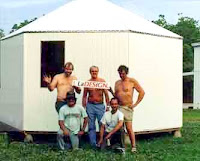ARCHIMEDE INSTITUTE
TSUNAMI 'FLOATING SOLUTION'
Although this house was designed for a flooding site, it could handle most tsunamis with its rigidity and steel clad paneled underbelly at a high stance. For the much less probable tsunamis that could rise above the door sills and create massive amounts of floating debris, we suggest soluble bolt anchors on top of each column. This way the house will float as a rigid unit capable of taking a lot of hits and yet remain safe. Of course a solid chain would tether it to a reliable point on the ground. This is not a compromise as both safety and practicality are maintained in a relatively low-cost house.
WHO COMES HERE - OUR TRAINING SEMINARS
We have a one-on-one training program for civil employees wanting to upgrade their palette of choices in the rebuilding arena. These two week seminars are held in Cantamar MX, and cost includes lodging in a beach condo as well as transit to and from the San Diego Airport. The cost of a complete session in $1000., including the documentation that is transferred from computer to computer. Trainees are invited to bring portable drives with at least 300 gigs of free space. Diplomas are given and most governments recognize our institution for tax purposes applied to professional training and career upgrading.
2013-2020
- By the end of 2012, the Institute will be well known to the faculty of most Architectural Schools throughout the world. It would conceivably by then be very easy to recruit students for summer stages at our different facilities. By gaining insight in our methods as a trade-off for their help, those students will vastly enrich and help spread the Archimede gospel for stronger building shells. Seeding the entire profession at this early date in their career, many of these students will chose to forego conventional practice later on and devote their energies to promoting the thousands of needed shelters before the end of the 2010 decade.
- On the same schedule, our affiliate offices would recruit local contractors willing to invest a month of their time to learn the Archimede ways. By 2012, we hope to have had the time and energy to clone our head office in several other locations closer to frequent disaster afflicted areas.
2010-2020

These are the eight years where the hurricane shelter project will really be implemented worlwide. After a promotional campaign in 2008, we expect to be training crews in Mexico to manufacture the components to produce and erect these in the affected zones of their country. These people sent to us by their government or NGOs will live with us in Cantamar for the time it takes for them to fully integrate our techniques.
2008-2010
We intend to use the rest of 2007 to raise money and to get in touch with the rebuilding authorities in several areas, namely in Bangladesh, Peru, and Haiti, recent victims of natural disasters. We are completing several design programs:
(* single asterisk indicate existing links that we are developing-** Our home office)
 A cyclone shelter for 500 people at below $60K. one that can be completed in 1 month by a semi-skilled crew.
A cyclone shelter for 500 people at below $60K. one that can be completed in 1 month by a semi-skilled crew.- A red cross first aid station that can resist cyclones and tsunamis.
- A tsunami-proof kit house at below $30K, unfinished.
- An aseptic heli-portable surgical module that is autonomous and air conditioned.
- A container based portable factory capable of producing 100 panels a day for shelters above.
- Our new institute training program for manufacturing.
(* single asterisk indicate existing links that we are developing-** Our home office)
2007

Our Cantamar MX office and research facility (on the right in aerial view ) has in 2007 launched the Institute as we know it, graduating from 35 years of design and manufacturing into a non-profit society. Its aim is to implement sturdier and more economical construction techniques for the benefit of populations afflicted by natural disasters on a regular basis. The long rectangle shows our shop, part of which is periodically transformed into a wind tunnel for testing refugee tents. That part has an earth floor simulating average soils where such tents are often erected. We have found in 2007 some clever solutions to the wind problems that can be seen here.
DISASTERS
- Earthquakes and Earthquake proofing
- Floods
- Hurricanes and Hurricane proofing
- Tsunamis and Tsunami resistance and protection
- Wildfires
- Landslides
- Termites and Insect proofing
- Permafrost damage and
- Climate changes
- Wind storms
OUR FIRST 'OPERA'

 Thanks to a generous fund provided by Private Capital Inc. and it's owner, Ronald Smith (left on photo), the Archimede Institute has fully tested a series of small buildings that can be erected in a few hours. The one shown here is an aseptic field operating room that is air conditioned and can be hosed down clean inside and out. The heaviest component weighing in at 30 kilos, two nurses could theoretically put one up on their lunch break, to use a little Cajun exageration. The entire package can be air freighted in a small crate that fits in any air cargo hold.
Thanks to a generous fund provided by Private Capital Inc. and it's owner, Ronald Smith (left on photo), the Archimede Institute has fully tested a series of small buildings that can be erected in a few hours. The one shown here is an aseptic field operating room that is air conditioned and can be hosed down clean inside and out. The heaviest component weighing in at 30 kilos, two nurses could theoretically put one up on their lunch break, to use a little Cajun exageration. The entire package can be air freighted in a small crate that fits in any air cargo hold. Note: Photo taken on a hot day after a few Cajun beers. ;-) I'm the sober one on the right.
Jacques
The Rhombic Dodecahedral Geometry

(text from Wikipedia) The rhombic dodecahedra honeycomb is a space-filling tessellation (or honeycomb) in Euclidean 3-space. It is the Voronoi diagram of the face-centered cubic sphere-packing, which is believed to be the densest possible packing of equal spheres in ordinary space (see Kepler conjecture).
It consists of copies of a single cell, the rhombic dodecahedron. All faces are rhombs, with diagonals in the ratio 1:√2. Three cells meet at each edge. The honeycomb is thus cell-transitive, face-transitive and edge-transitive; but it is not vertex-transitive, as it has two kinds of vertex. The vertices with the obtuse rhombic face angles have 4 cells. The vertices with the acute rhombic face angles have 6 cells.
The rhombic dodecahedron can be twisted on one of its hexagonal cross-sections to form a trapezo-rhombic dodecahedron, which is the cell of a somewhat similar tessellation, the Voronoi diagram of hexagonal close-packing.
In plain English: If you took a can of peas, drained it and packed some of the peas tightly between your two cupped hands, you would obtain:
- a bunch of peas each with twelve identical flat faces, parallellogram shaped
- no void between each peas until you separate them
- very messy hands.
- The resulting shape is the strongest thing next to a sphere
- It is arguably the strongest object you can create using flat surfaces
Hundred of houses built this way have been trhough terrible hurricanes and earthquakes,
SOLID GEOMETRICAL CHOICES FOR STRENGTH
This merit is firstly the unusually high resistance to side loads. This diagram makes it easy to understand what makes this possible. Whatever the direction
Subscribe to:
Posts (Atom)


